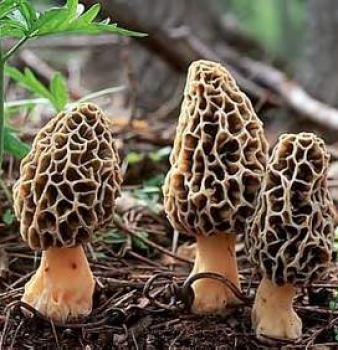 Beautiful North Idaho has so much to offer! One great thing is all the edible mushrooms you can find. And spring is a great time to find them. But, you need to know what you’re doing and what you’re looking for as there are more poisonous mushrooms than edible ones. Check out some mushroom identification and tips below.
Beautiful North Idaho has so much to offer! One great thing is all the edible mushrooms you can find. And spring is a great time to find them. But, you need to know what you’re doing and what you’re looking for as there are more poisonous mushrooms than edible ones. Check out some mushroom identification and tips below.
The most common and popular mushroom in our area is the morel. You have likely heard about morels, and may even have had the great pleasure of tasting one, but you want to be sure you know what you’re looking for if you choose to more hunt.
Where To Find Them 
Don’t expect an expect morel hunter to share their secret more picking spots, for many reasons. The majority of morels grow in the wild, so even if they know you well, they will likely keep their spot a mystery. They wouldn’t want to visit their spot and find it picked clean.
But, as a new morel hunter, there are some tips on places to look. For whatever reason, they tend to grow in areas that were burned the previous year. Searching in a recent burn is a great way to get your feet wet and figure out exactly what you’re looking for.
Additionally, morels tend to grow in cottonwood forests, under elms and by rivers. Once you find one, you will likely find more.Unfortunately, the growth of morels are a bit perplexing and difficult to find which adds to the reward when you do find them.
How To Identify
You could be looking in all the right places, but if you don’t know what you’re looking for then you won’t get very far. Below are a few tips to positively identify a morel:
- Honeycomb-like cap with brown pits and ridges
- The cap is fully attached to the stem and doesn’t pop off
- If you slice the mushroom in half, it will be hollow inside
False Morels
The are a couple morel lookalikes in the area that you will want to keep a lookout for when morel hunting as these mushrooms are poisonous:

Brain Mushroom
-
Hooded False Morel
Brain Mushroom – The cap of this mushroom is more or less convoluted, round & brain like which come in various shades or brown to reddish brown. The difference between this mushroom and a morel is that the Brain Mushroom doesn’t have a honeycomb like cap. These mushrooms grow at the same time and in the same habitat as a true morel.
- Hooded False Morel – The cap is brown and saddle shaped, it starts out smooth but becomes more convoluted/wrinkled as it matures. So, this mushroom also doesn’t have a honeycomb like cap either. It also grows at the same time and in the same habitat as a true morel.
Both of these morels grow in north Idaho and are poisonous. They can cause adverse physically reactions within 1-24 hours of ingestion and I would advise avoiding at all costs.
When To Look
The basic answer is spring time, so late April-early May. But that all depends on the year, elevation and temperature. Morels like warm soil, so you will likely find them in the lower elevations earlier in the year and higher elevations later on. Morel season could last up to 2 months. The best time to look is on a sunny day, after a rainstorm.
How To Pick, Process, Cook And Preserve
Like it was stated earlier, morels grow mostly in the wild. So you want to be sure to pick them correctly to allow for them to grow next year. Be sure to pinch or cut them at the base. Do not pull them up or remove the root ball. Additionally, carry them out with a woven basket or mesh bag. This allows for them to release and spread spores. Do not use a plastic bag which not only stops the spread of spores but it also makes your mushrooms get slimy quick.
 Once you get your mushrooms home you want to be sure to immediately get them processed. First, get them washed. There are a couple schools of thought regarding washing a mushroom. You could just brush off any dirt and inspect for worms/pests. Not using water because that could cause the mushroom to soak it up and dilute the flavor. Or, you could soak them in salt water overnight to get rid of any worms/pests.
Once you get your mushrooms home you want to be sure to immediately get them processed. First, get them washed. There are a couple schools of thought regarding washing a mushroom. You could just brush off any dirt and inspect for worms/pests. Not using water because that could cause the mushroom to soak it up and dilute the flavor. Or, you could soak them in salt water overnight to get rid of any worms/pests.
To prepare the mushrooms, they do need to be cooked. They taste the best when harvested at just the right time and cooked shortly after they are picked. These mushrooms are choice, highly priced and sought after so be sure to take your time and research the best way to prepare the mushroom to enhance the flavor. Click here for some resources I’ve found.
If you don’t plan to eat them right away, it’s best to store them in a brown paper bag on your counter for no more than a few days. Or, if you’d like to preserve them for longer, you could always dry them. You could use a dehydrator to do this or just thread them on a string and let it dry in an area that is hot, dry and with a slight breeze.
Other Mushrooms To Lookout For
There are many edible mushrooms in North Idaho, some show in spring and some grow in fall. It’s best to do your research to determine what’s edible and how to harvest and cook these mushrooms. Click here for a quick list of some edible mushrooms in North Idaho, and how to identify them.
Here are some gorgeous pictures of some wild mushrooms taken right here in our national forests:
Credit: TwinEagles, IdahoStatesman, FunFal Forager, Riverman
 Facebook
Facebook
 X
X
 Pinterest
Pinterest
 Copy Link
Copy Link











